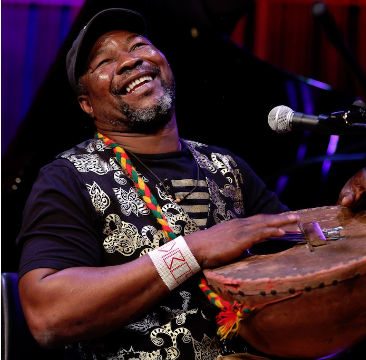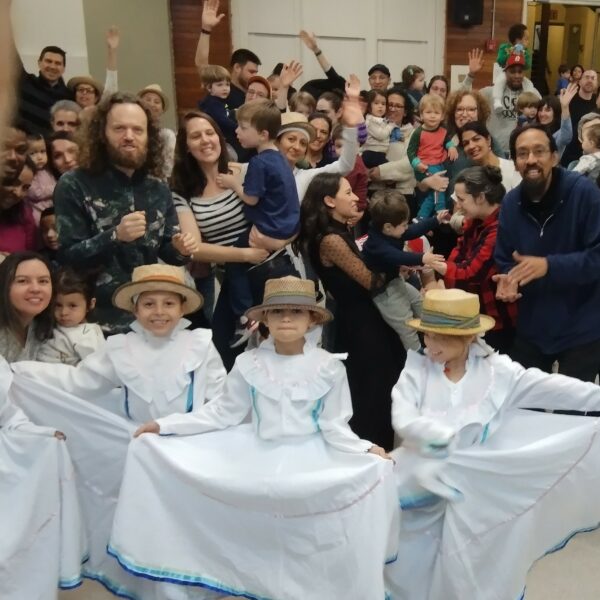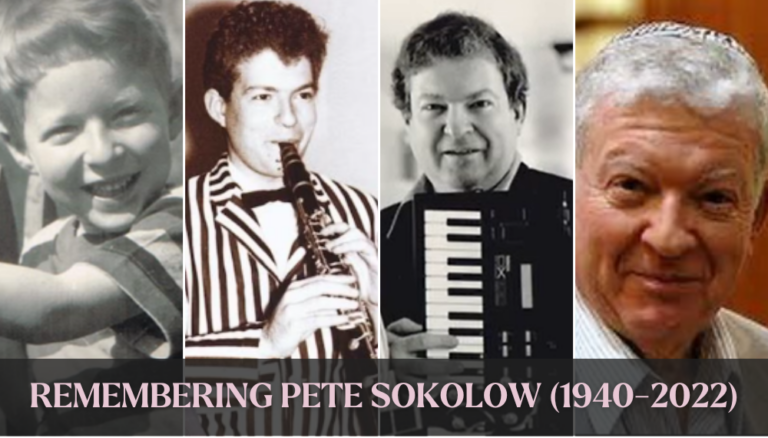CTMD is pleased to honor Bulgarian Roma saxophonist Yuri Yunakov at our June 4, 2009 Benefit Event entitled “A Night in Istanbul.” Yuri is a long-time friend of CTMD and featured performer of our Touring Artists program, as well as a major innovator whose music is rooted in the traditions of the cosmopolitan Thracian hinterlands of Istanbul.
A few weeks ago, Ethel Raim and I had the pleasure of sitting down with Yuri to learn more about his musical heritage and special role in the development of the electrifying genre known as “Bulgarian Wedding Music.” Special thanks go to Cathie Springer for her help in translation.
A Musical Dynasty in Thrace
Of Turkish Roma (Gypsy) descent, Yuri was born with the name Hussein Yunakov in 1958 in Haskovo, a city in the Thracian region of southeastern Bulgaria. For centuries Thrace has been a rich melting pot of culture – a cosmopolitan borderland filled with Turks, Bulgars, Macedonians, Greeks, Roma, Sephardic Jews, Armenians, Albanians and others.
Cigarette production remains a major industry of Haskovo, with the government-owned Haskovo-BT company a large processor and exporter of tobacco and cigarettes. Tobacco factories were particularly a major employer for the Roma of the Haskovo mahala, or Roma quarter. Most of the musicians of Haskovo were employed by the tobacco factory and supplemented their incomes through wedding performances on the weekends.
The Yunakov family is well known through the region for their musicianship. Yuri’s grandfather “Kemence” Ali Yunakov (b. 1904) was a renowned violinist and singer from Sliven, Bulgaria (in Turkish tradition, master musicians are given an honorific name referring to their instrument, in this case “kemence,” the Turkish name for violin). Yuri’s paternal grandmother Aishe was from the border region of Greece and Bulgaria.
Unlike the musicians on his father’s side, Yuri’s maternal grandfather Ismail was a kasap (Turkish for “butcher”), quite a respectable livelihood in Haskovo. He was born in the great Mediterranean port city of Izmir, formerly known as Smyrna prior to the Greco-Turkish population exchange of 1922. His wife, Yuri’s grandmother, died rather early. Yuri notes that his grandfather purchased the animals he butchered and then sold them, making a distinction with less profitable kasaps who were paid to slaughter but never profited from buying and selling the animals.
In his popular ensemble, Kemence Ali was backed by Yuri’s father, “Dancho” (whose real name was also Hussein), on a Bb Albert-system clarinet, and Yuri’s uncles on accordion and two duvale, large double-headed drums known as “tapans” in other parts of the Balkans. Depending on the occasion, the ensemble might also feature brass instruments such as trumpets and trombones, and be augmented from time to time by Armenian and Jewish musicians – Yuri particularly remembers Armenian oud players.
The ensemble performed a mix of Roma and Turkish repertoire, mainly at Rom weddings (rarely hired for Bulgarian affairs) as well as occasional appearances on Turkish-language radio.
Traditionally, the ceremonies involved in a Roma wedding in Thrace spanned much of a week. The events started on Tuesday before the nuptials with the bride performing a “show and tell” of the dowry her bridegroom was to receive. The next day, the women would gather for a ritual bath of the bride at a local hamam (Turkish bath).
Two bands would be hired by the bride’s father on the Saturday of the wedding—one would play for the women, the other for men (larger, enterprising ensembles could provide musicians for both parties). There was also a place for music provided by zurna (double-reed wind instrument) accompanied by duval, used to commemorate the bride’s departure (both physical and metaphoricall) from her family’s household. On the Monday after the nuptials, the women would gather at the house of the bride to drink, talk and sing.
A variety of dance forms were performed: line choreographies such as prava horo, kasapika horo (butcher’s dance), elenino horo (Greek dance), paidushko, and what Yuri describes as the “Gypsy 9/8” slow dance, as well as cocek circle dances. During this period, men and women would dance separately. Musicians would also be expected to provide listening music for entertaining guests at the banquet table, including highbrow Turkish classical forms, such as pesrev and, less frequently, saz semai.
Over time, Dancho took command of his father’s ensemble and introduced changes in instrumentation and repertoire. Brass instruments were eliminated, and a drum kit and electric bass were utilized (despite the use of a kit drum, a young Yuri got his start playing duvale in the ensemble). Electronic amplification was introduced. The wedding became truncated to a two-day affair, and the wedding party morphed into a mixed affair with men and women dining and dancing together. The variety of dances performed was diminished as well: in terms of line dances, only pravo horo and kasapski horo were now commonly performed at weddings.
Yuri’s Musical Development
When Yuri was eight, he became part of a “Bitov” ensemble being organized at the local zariya (cultural center) by Mitko Angelov. Bitov music features instruments not commonly seen in Thrace, such as gadulka (lap fiddle), gaida (bagpipe), tambura (lute) and kaval (end-blown flute).
While these instruments were traditionally performed by solo instrumentalists, in the 1940s, mixed-instrument Bitov ensembles began performing frequently on Bulgarian radio and recordings employing standardized pitch and virtuosic performance styles. Later, as was common throughout Eastern Europe, larger national and regional folk orchestras were assembled across Bulgaria (in particular Phillip Koutev’s Sophia-based State Ensemble for Folk Songs and Dances) performed highly arranged renditions of traditional melodies.
Yuri recalls Angelov as a musical visionary who attracted many young people to perform Bulgarian folk music. He came to Yuri’s school and went class to class recruiting young musicians. When Yuri expressed interest in kaval, Angelov provided him one on the spot; within two hours, Yuri was able to generate music (he had already learned some Bulgarian music from his father on clarinet).
Yuri was the only Roma in the ensemble, which grew to include over 100 youth. Both music and dance were presented in performances throughout Haskovo.
Performing with the zariya ensemble during the week, Yuri continued to play weddings with his father’s ensemble on the weekends. He remained with the zariya group for about five years. During this time, Yuri initiated a short but successful foray into professional boxing that brought him several national titles.
Eventually, Yuri’s older brother Ahmed took over leadership of the ensemble from his father. With Dancho moving over to saxophone, the new band, named “Aida” after a large local hotel, featured Ahmed and Yuri on lead Boehm-system clarinets, as well as two male singers backed by electric guitar, bass guitar, two accordions and drums. Aida performed a mix of Bulgarian, Greek, Turkish and Roma music. Though he was happy to be relieved of the responsibility of managing the ensemble, Dancho died prematurely when Yuri was only seventeen.
Through his work with Ahmed, Yuri soon gained notoriety amongst leading Roma musicians working to create a new style that the University of Oregon’s Carol Silverman describes as emphasizing “virtuoso technique, improvisation, fast speeds, daring key changes, and eclectic musical sources such as jazz, rock, Turkish, and Indian musics, as well as Balkan village music.”
Yuri attracted the attention of accordion virtuoso Ivan Milev, from the town of Mladost. Milev convinced Yuri and Ahmed to join his band and they played with Milev for a number of years before returning to their own family ensemble. Like Yuri, Milev has since immigrated to the U.S. and is very active in New York’s Balkan music scene.
Yuri’s time with Milev had a big impact on his career. Milev encouraged Yuri to focus on saxophone, rather than clarinet, and Yuri worked with Milev to create a nuanced and virtuosic technique for the saxophone that complemented the other major melody instruments—clarinet and accordion. Yuri credits accordionist Neshko Neshev’s father as being the first Wedding Music saxophonist he knew of, but, according to Silverman, it was Yuri who “created the saxophone’s role in this style.”
For many years Bulgaria’s Communist government tried to suppress the growing popularity of Wedding Music, but the authorities eventually relented and sanctioned a festival dedicated to the genre in Stambolova. While acknowledging a national craze dominated by Roma musicians with cosmopolitan artistic influences, the totalitarian government was simultaneously active in censorsing many leading musicians.
Trakija and Beyond
After a strong showing in his first Stambolova festival, Yuri was approached by clarinetist Ivo Papasov, the leading wedding musician in the country, to join his band Trakija. He reluctantly agreed, as he feared upsetting his relationship with Ahmed.
Through his performances with Trakija beginning in 1983, Yuri became renowned throughout Bulgaria, performing frequently on radio and TV. Weddings featuring Trakija attracted thousands of attendees. As Silverman puts it, “in the 1980s Yunakov and his band Trakija were household names in Bulgaria, and people would wait months or even years to engage them for weddings, concerts and other events. They were the equivalent of rock stars in the West, with many bookings and thousands of fans.” The group’s huge popularity created a backlash with the government—Yuri and Papasov were twice imprisoned for their musical activities.
In 1989, with the help of Joe Boyd, an American record producer based in England, Papasov’s band was brought to the U.S. for the first time to perform for the Queens Ethnic Music and Dance Festival organized by the Center for Traditional Music and Dance (then known as the Ethnic Folk Arts Center) at Bohemian Hall in Queens. This was only the ensemble’s second performance outside of Bulgaria, following a concert in London.
During the American visit, the Papasov ensemble performed on David Sanborn’s nationally-broadcast TV program, Night Music. A leading jazz saxophonist himself, Sanborn was so struck by Yuri’s playing that he presented him with a new instrument.
Since immigrating to the U.S. in 1994, Yuri has been in great demand on both coasts as a musician of unending energy and power. While playing for weddings and family gatherings in Bulgarian, Turkish and Macedonian Roma communities, he continues to perform around the world fronting his own ensemble, as well as reuniting with Paposov from time to time for tours and recordings.
Yuri Yunakov is a CTMD Touring Artist.
Recordings With Ivo Papasov:
-Orpheus Ascending (Hannibal/Rykodisc)
-Balkanology (Hannibal/Rykodisc)
-Together Again: Legends of Bulgarian Wedding Music (Traditional Crossroads)
Recordings by the Yuri Yunakov Ensemble:
-New Colors in Bulgarian Wedding Music (Traditional Crossroads)
-Balada-Bulgarian Wedding Music (Traditional Crossroads)
-Roma Variations (Traditional Crossroads)




